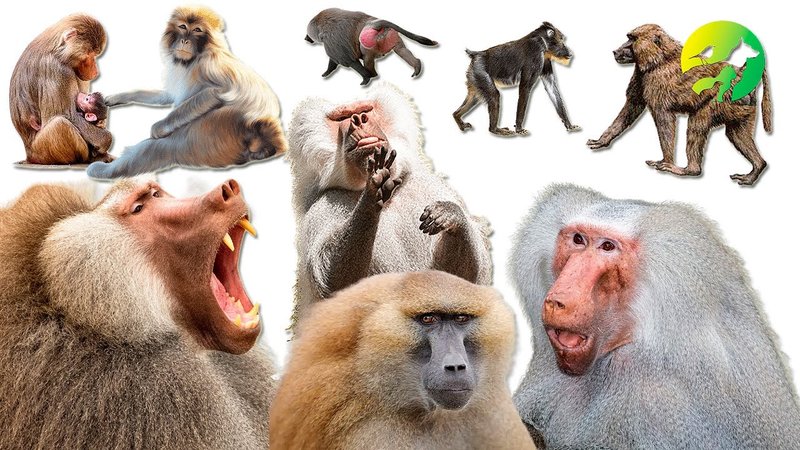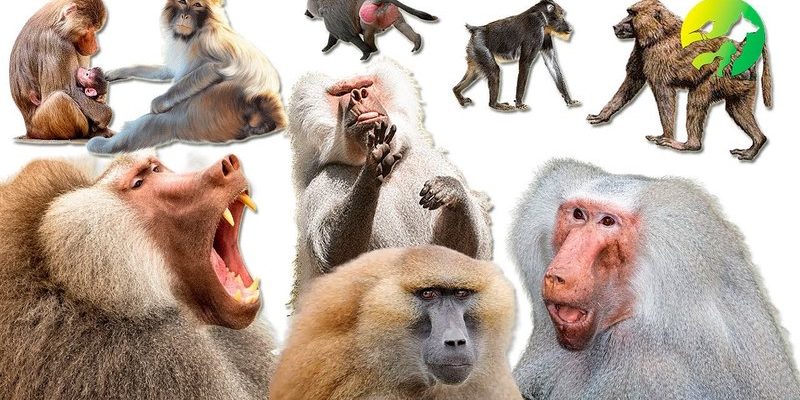
Understanding the differences between these animals isn’t just fascinating; it gives us insight into nature’s creativity. Some of these creatures live in similar habitats or share similar behaviors, which can make them seem like baboons at first glance. So, grab your binoculars and let’s delve into this wild world!
1. Mandrill
The mandrill is often confused with the baboon, and it’s easy to see why! With their vibrant facial markings and similar size, they’re like the artsy cousins of the baboon family. Mandrills are primarily found in the rainforests of Central Africa, which is quite different from the baboon’s more open savannah habitat.
Here’s the thing: while both are part of the same family, Cercopithecidae, mandrills have much brighter colors. The males sport blue and red skin on their faces, making them look like they just walked off a movie set. In terms of size, mandrills can be larger than baboons, reaching up to 3.3 feet in length and over 100 pounds!
Key Differences:
- Mandrills have more colorful faces compared to baboons.
- They are larger, especially the males, who sport striking colors.
- Mandrills live in dense forests, while baboons prefer open areas.
2. Gelada
Next up is the gelada, often called the “bleeding heart monkey” due to the red patch of skin on its chest. Found in the highlands of Ethiopia, geladas are very social creatures, much like baboons. They spend a lot of time foraging for grass, which makes up a huge part of their diet.
What sets geladas apart is their unique behavior. They walk on all fours and have similar social structures to baboons, but when they sit, they often sit upright, which can look pretty impressive. If you spot one, you might catch them displaying their red chest while socializing or grooming each other—a display that’s both fascinating and adorable!
Key Differences:
- Geladas feed mostly on grass, unlike baboons.
- They have distinct red chest markings not found on baboons.
- Geladas have a more upright sitting posture.
3. Chimpanzee
You might be surprised to see chimpanzees on this list, but they do have some similarities with baboons. Both belong to the primate family and show complex social behaviors. However, chimpanzees have a more slender build and longer limbs, giving them a different look overall.
Living primarily in the forests of Africa, chimpanzees are known for using tools and displaying intelligence similar to ours. They can make and use sticks to extract termites from mounds, a feature that sets them apart from baboons, who are more ground-foraging creatures. Because of their close genetic relationship to humans, it’s captivating to observe their interactions and problem-solving skills.
Key Differences:
- Chimpanzees have a more slender, human-like build.
- They are known for using tools, while baboons typically do not.
- Chimpanzees live in forested areas, in contrast to baboons’ savanna habitats.
4. Macaque
Macaques are another primate that can be confused with baboons, especially because they are very adaptable and live in varied environments, from snow-covered mountains to tropical forests. Japanese macaques, for example, are famous for their hot spring baths!
Despite their similarities, macaques tend to be smaller and have different facial structures. You might notice that their faces are less pronounced than those of baboons. Plus, macaques have a more varied diet, often incorporating fruits and insects into their meals alongside traditional vegetation.
Key Differences:
- Macaques are generally smaller and more varied in color.
- They have less pronounced facial features compared to baboons.
- Macaques inhabit a wider range of climates and environments.
5. Capuchin Monkey
Moving onto capuchin monkeys—we’re still in the primate family, but these little guys pack a personality punch! Typically found in Central and South America, capuchins are much smaller than baboons and known for their intelligence and dexterity.
Often seen in movies or as adorable pets, capuchins are social and love to play. Unlike baboons, they have a distinctive tuft of hair on their heads that gives them a more playful appearance. Their vocalizations are also quite different, often resembling high-pitched squeaks rather than the gruff calls of baboons.
Key Differences:
- Capuchins are significantly smaller than baboons.
- They have a tuft of hair on their heads.
- Capuchins inhabit rainforests, contrasting with baboons’ savanna locations.
6. Vervet Monkey
Vervet monkeys are often seen in Africa and share some physical traits with baboons, like similar body shapes and social behaviors. Their striking greenish-gray fur and expressive faces can easily catch your eye.
These monkeys are known for their intelligence and ability to adapt to various habitats, whether it’s savannahs or urban areas. Unlike baboons, vervet monkeys are smaller and have smaller, rounder faces. Additionally, they often have a more playful demeanor, making them fun to watch as they swing through trees and scavenge.
Key Differences:
- Vervet monkeys are smaller and have rounder faces.
- They often adapt to urban environments, unlike baboons.
- Their vocalizations are varied and distinct from those of baboons.
7. Squirrel Monkey
Squirrel monkeys might be small, but they share a playful spirit with baboons. Native to Central and South America, these cheeky little monkeys are usually covered in golden-yellow fur and have very expressive faces. They are much smaller than baboons, with a body length of around 16 to 24 inches, excluding their tails.
Their social structure is similar to that of baboons, but they tend to live in smaller groups of 10 to 40 individuals. Squirrel monkeys are known for their acrobatic skills, often bounding through the trees in a way that makes you wonder if they’re just showing off!
Key Differences:
- Squirrel monkeys are tiny compared to baboons.
- They have distinctive golden-yellow fur and expressive features.
- They are highly acrobatic and tend to live in smaller social groups.
8. Howler Monkey
Howler monkeys take their name from their vocalizations, which are some of the loudest in the animal kingdom. Found in Central and South America, they have a robust body structure and are known for their long tails, which they use for balance.
While howler monkeys and baboons both live in tree-dense areas, howlers primarily feed on leaves and fruits, giving them a distinct dietary preference. Their faces are also broader, giving them a more formidable appearance, which is quite different from the baboon’s look.
Key Differences:
- Howler monkeys are known for their loud vocalizations.
- They have broader faces and robust bodies.
- Their diet mainly consists of leaves and fruits, unlike baboons.
9. Spider Monkey
Another intriguing cousin of the baboon is the spider monkey. With their long limbs and prehensile tails, they are like nature’s acrobats. Native to Central and South America, spider monkeys are incredibly agile and prefer living high up in the trees.
Their black fur and slender bodies give them a distinct look compared to the bulkier baboons. While both monkeys share similar habitats, spider monkeys tend to be more solitary and less social than baboons, which is an interesting contrast to their active lifestyles.
Key Differences:
- Spider monkeys are much longer and more slender than baboons.
- They have prehensile tails for better climbing.
- They are more solitary compared to the social nature of baboons.
10. Tamarin
Finally, let’s talk about tamarins. These tiny primates are known for their adorable looks and fluffy fur. Native to Central and South America, tamarins are much smaller than baboons and have distinctive facial hair that can make them look like little old men!
Tamarins are social creatures too, living in family groups that help with foraging and childcare. But unlike baboons, who are often dominant and assertive in their interactions, tamarins tend to be more gentle and playful. Their smaller size and distinct fur patterns make them a delight to watch.
Key Differences:
- Tamarins are much smaller and have fluffy facial hair.
- They are gentle and playful compared to the more assertive baboons.
- Their habitats are often in dense forests, unlike baboons’ open savannas.
In conclusion, while baboons might be the attention-grabbing stars of the primate world, there’s a whole cast of characters that share similarities with them. By understanding the distinct traits of these animals, we gain a richer appreciation for the diversity of life on our planet. Next time you spot a baboon, remember that it has some fascinating cousins in the animal kingdom! Whether you’re watching them in the wild or learning about them from afar, each of these animals has its own story to tell.

